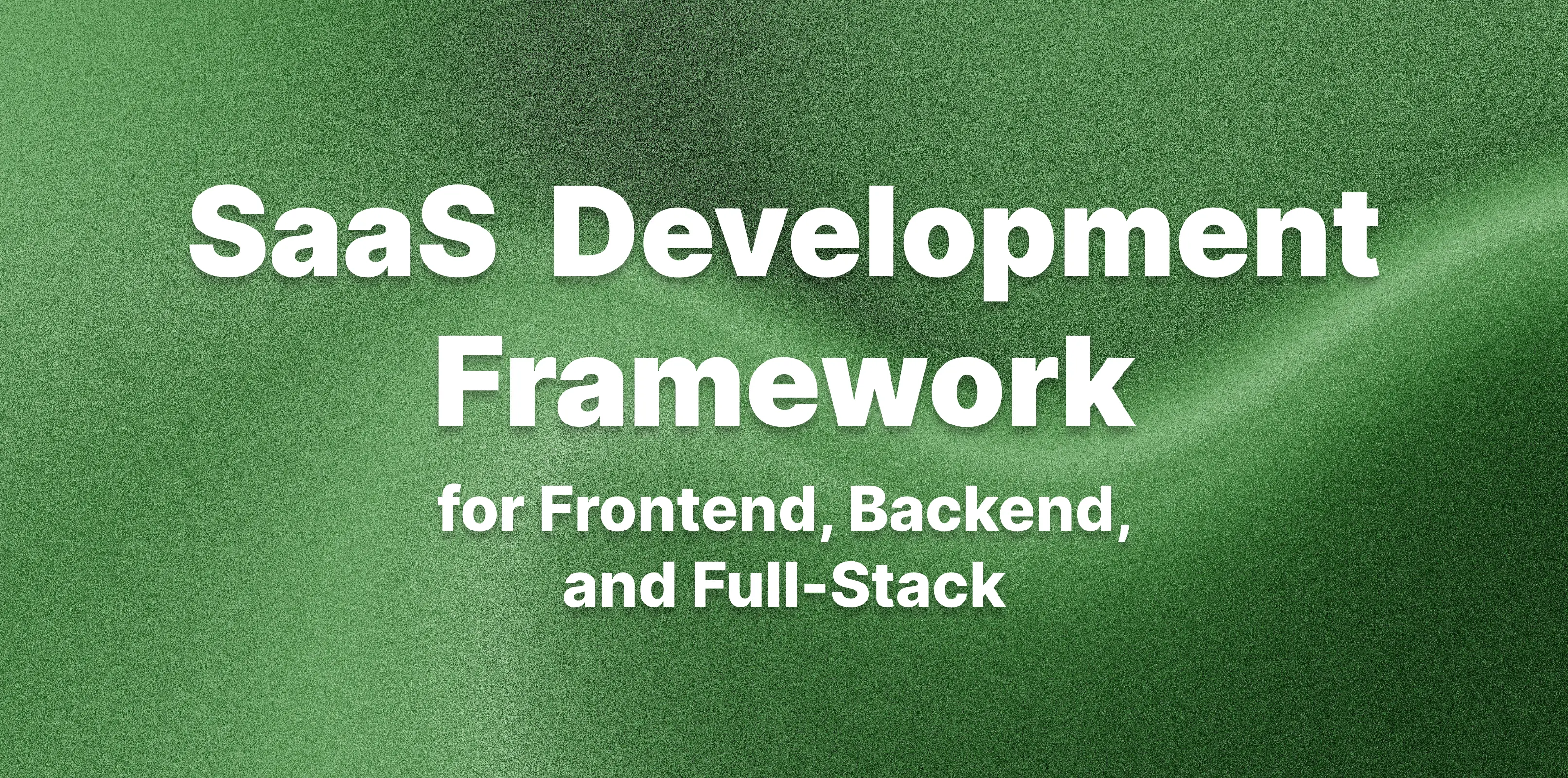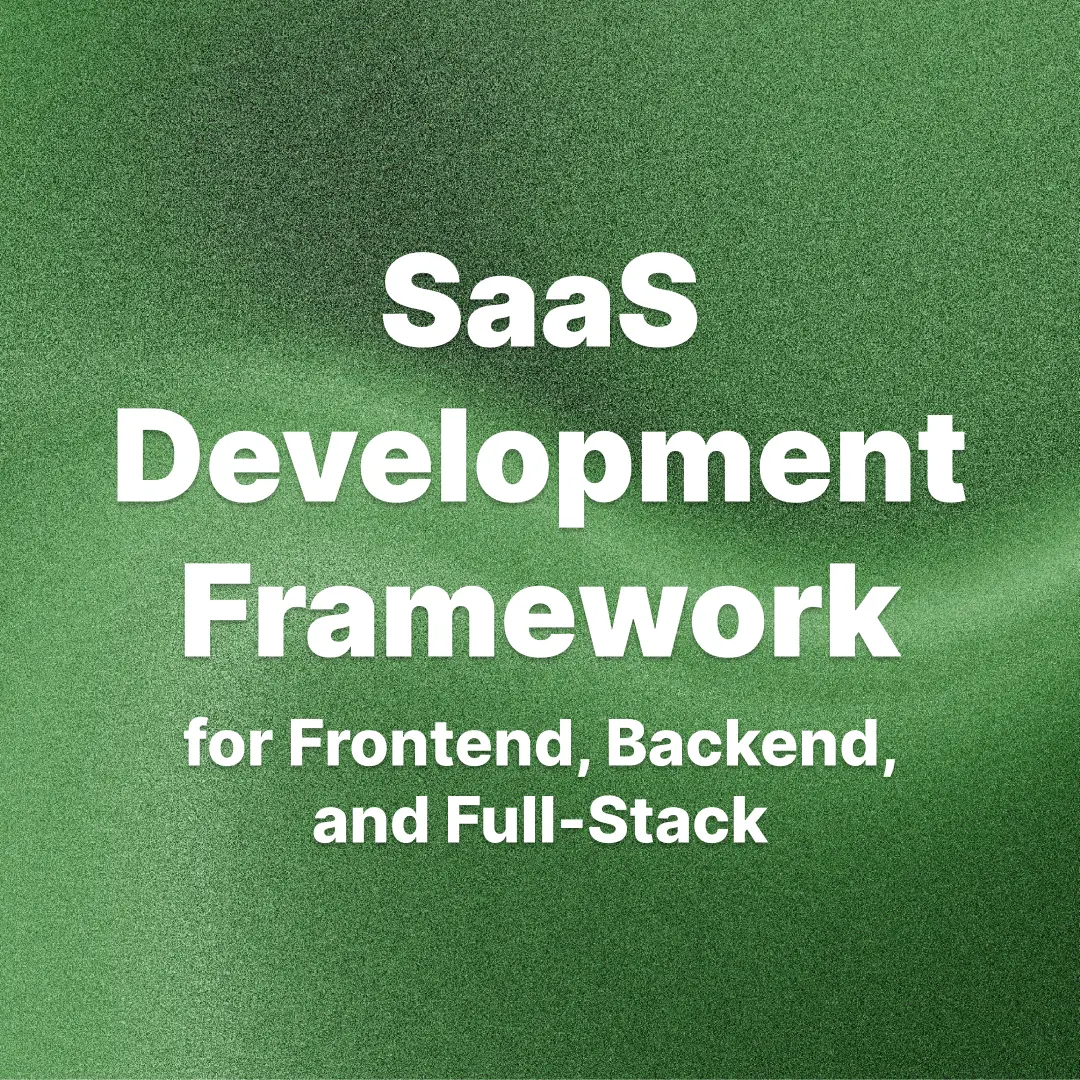Top SaaS Development Frameworks for Frontend, Backend, and Full-Stack [2026]
Top SaaS Development Frameworks for Frontend, Backend, and Full-Stack [2026]
September 30, 2025•9 min read

I hope you enjoy reading this post. If you want us to do your frontend development or design, click here.
Author: Alex Vasylenko | Founder of The Frontend Company


Choosing the right SaaS development framework is one of the most crucial strategic decisions you can make for your company and product. The framework you use determines how fast your product evolves, how easily it scales, and how much money and time you'll spend along the way.
Make the right choice, and you unlock the full potential of your SaaS. Get it wrong, and you'll be paying for it in delays, rewrites, and technical debt.
At The Frontend Company, we've worked with dozens of SaaS businesses from the US and Europe, guiding them through these choices. We've seen firsthand how the proper frontend and backend frameworks can transform a product's velocity, maintainability, and user experience.
In this article, I'll break down the best SaaS frameworks for frontend and backend development. You'll see their benefits, standout features, and how they power some of the world's biggest SaaS products.
What is a SaaS Development Framework and Why Does It Matter?
A SaaS development framework is a collection of tools and libraries providing a structured foundation for building web applications. Frameworks come with prebuilt components and best practices baked in, which lets your team focus on your app's unique features instead of low-level basics.
For example, frameworks often handle common needs like database access, user authentication, and MVC structure out of the box.
Why Frameworks Matter for SaaS
Speed and agility are everything in SaaS. A good framework reduces development time and time-to-market by offering reusable parts and automation.
The right framework helps you move faster and build a more robust product.
Beyond productivity, frameworks aid scalability and security – two critical SaaS concerns. Moreover, framework patterns stimulate organized, modular code that's easier to scale and update as your user base grows. With SaaS apps expected to serve potentially thousands or millions of users, this structural integrity is vital.
Top Frameworks for SaaS Development
Before jumping into the list, it's important to understand that not all frameworks do the same job in SaaS. They fall into three main categories, and each plays a different role in how your product works and grows.
Frontend frameworks are all about the user experience. They power the dashboards, real-time updates, and interfaces your customers interact with every day. In SaaS, this layer defines how fast and easy your product feels.
Backend frameworks handle the heavy lifting behind the scenes. They manage data, business logic, security, and scaling. If the frontend is the face of your SaaS, the backend is the engine that keeps it running smoothly.
Full-stack frameworks cover both, giving teams tools to build the UI and server logic in one place. They're beneficial for startups or small teams that need speed and simplicity to get to market fast.
With these roles clear, let's dive into the best SaaS development frameworks for frontend, backend, and full-stack in 2026.
Best SaaS Frameworks for Frontend Development
Here is the list of the best frontend frameworks for SaaS development:
React — The Default SaaS Framework for Modern Frontends
React is a component-based JavaScript library created by Meta, and it is the default choice for building scalable, interactive, and high-performance SaaS user interfaces today.

At The Frontend Company, we recommend React to our clients in 8 out of 10 cases, because it covers the full SaaS needs — from real-time dashboards to complex enterprise apps.
Best SaaS Features:
Handles real-time interactions and complex UI states without breaking maintainability.
Huge ecosystem with ready-to-use tools for authentication, payments, analytics, and data visualization.
Works great with TypeScript for safer scaling and safe refactoring.
Pairs with frameworks like Next.js for speed, SEO, and serverless deployment.
Use when:
You're building real-time SaaS products like collaboration tools, chat apps, or live dashboards where UI updates must be instant.
You need scalable admin panels or multi-tenant dashboards with complex tables, filters, and permission systems.
You want fast time-to-market but also a foundation that can handle growth without rewrites.
You want a unified tech stack: React on the frontend, React Native for mobile, and Node.js on the backend (for hiring simplicity and productivity).
React means faster hiring, easier scaling, and fewer surprises down the road.
Angular — SaaS Framework for Enterprise-Grade Apps
Angular is a full-fledged frontend framework maintained by Google, and it's all about structure. Unlike React, which gives more flexibility and leaves architectural choices to the team, Angular enforces strict patterns and conventions.

This makes it especially valuable for SaaS companies planning to scale their engineering team: everyone follows the same "rulebook," which keeps the codebase consistent and predictable.
It's heavier than React or Vue, but for large SaaS applications that require alignment and long-term stability, Angular delivers reliability.
Best SaaS Features:
Complete framework with routing, forms, state, and testing included.
Strong TypeScript foundation for safety and maintainability.
Enforces consistent architecture — less room for "creative chaos."
Built-in security features and enterprise-grade support.
Use when:
You're building a large SaaS app with multiple teams, and consistency matters more than flexibility.
You want strict guardrails so every developer works the same way.
Your SaaS requires robust long-term maintainability and strict coding standards.
You're in enterprise or compliance-heavy industries where predictability and security are non-negotiable.
Angular keeps the whole team playing by the same rules, producing code that scales without chaos.
Vue — SaaS Framework for Fast and Flexible Startups
Vue is a progressive JavaScript framework known for its simplicity and flexibility. It strikes a balance between the heavy structure of Angular and the flexible approach of React.

For SaaS teams, especially smaller ones, Vue offers a gentle learning curve and a clean way to build dynamic interfaces quickly. It's lightweight, approachable, and allows you to scale the complexity as your product grows.
Best SaaS Features:
Easy to learn and adopt — perfect for startups moving fast.
Built-in ecosystem (Vue Router, Vuex) for state management and navigation.
Clear separation of HTML, CSS, and JS within components = cleaner code.
Lightweight core with the ability to scale up complexity only when needed.
Use when:
You're building a startup SaaS and need to get to market quickly with a framework that's easy to pick up.
You want flexibility without the strict guardrails of Angular or the assembly required in React.
Your team is smaller and values simplicity in onboarding and development speed.
You're aiming for a SaaS product with rich but manageable UI interactions — dashboards, forms, and content-driven tools.
Vue gives you speed and flexibility — a perfect match for SaaS teams that need to ship fast without getting stuck in complexity.
Best SaaS Frameworks for Backend Development
Here is the list of the best backend frameworks for SaaS development:
Ruby on Rails — SaaS Framework for Rapid MVPs and Marketplaces
Rails is a full-stack framework built on Ruby, famous for its convention-over-configuration approach. It gives SaaS teams a clear structure and a massive ecosystem of prebuilt packages, allowing them to launch new features with speed and confidence.

Best SaaS Features:
Rich ecosystem for billing, payments, and user management.
Strong support for multi-tenancy and background jobs.
Well-tested patterns for SaaS subscription models.
Commonly combined with:
React
Next.js
Vue
Use when:
You need to launch an MVP quickly and validate your SaaS idea.
You're building marketplaces or subscription platforms where payments and accounts matter most.
Your team values speed and productivity over maximum performance optimization.
You want a proven path — Rails has powered SaaS from early stage to global scale.
Rails gets you from zero to market faster than almost anything else in SaaS.
Django — SaaS Framework for Secure and Compliant Apps
Django is a Python framework with a batteries-included philosophy. It comes with everything from authentication to admin dashboards out of the box. For SaaS founders in heavy industries, Django's security-first approach makes it a strong SaaS product development framework.

Best SaaS Features:
Built-in protections against XSS, SQL injection, and CSRF.
Auto-generated admin panel for quick internal tools.
Strong ORM and structure, meaning predictable and maintainable code.
Excellent fit with Python's ecosystem (data science, AI integrations).
Commonly combined with:
React
Next.js
Vue
Use when:
You're building SaaS in finance, healthcare, or compliance-driven industries.
You want a secure foundation from day one.
Your team works in Python and may need AI/ML integrations later.
You need an out-of-the-box admin to manage users, data, or content.
Django is a perfect choice when security and compliance are crucial.
Node.js / NestJS — SaaS Framework for Real-Time Collaboration
Node.js is a JavaScript runtime built for event-driven servers. It's excellent for real-time SaaS, where thousands of concurrent connections must be handled smoothly. NestJS builds on top of Node/Express, adding a structured, Angular-inspired architecture for large teams.

Best SaaS Features:
A non-blocking model enables efficient handling of thousands of concurrent users.
Perfect for WebSockets and real-time updates.
Same language across frontend and backend → easier hiring and onboarding.
NestJS adds scalability, testing, and a modular structure.
Commonly combined with:
React
Next.js
Vue
Angular
Use when:
You're building real-time collaboration SaaS (chat, whiteboards, dashboards).
You want a single language stack across frontend and backend for simplicity.
Your SaaS requires instant updates and live data streaming.
You need flexibility to architect microservices or serverless APIs.
Node.js is built for SaaS that lives and dies on real-time interaction.
Full-Stack SaaS Frameworks (Frontend + Backend in One)
Not every team wants to manage separate frontend and backend frameworks. Here is the list of the best full-stack frameworks for SaaS development:
Next.js — SaaS Framework for Serverless and SEO-Driven Apps
Next.js is a React-based full-stack framework that brings server-side rendering, static site generation, and API routes into one package. It allows SaaS teams to build both the frontend and light backend features without leaving the React ecosystem.

Best SaaS Features:
Server-side rendering & static generation = fast loads + SEO boost.
Built-in API routes mean a lightweight backend without extra services.
Excellent for serverless and edge deployments (Vercel, AWS Lambda).
Perfect for combining marketing site + app in one codebase.
Use when:
You want marketing + app shell in one stack for consistency.
Your SaaS depends on SEO visibility (marketplaces, SaaS directories).
You need serverless or edge-ready architecture out of the box.
You're already in the React ecosystem and want speed without spinning up a full backend.
Next.js lets you run your SaaS with one stack — frontend, backend APIs, and serverless delivery all in one place.
Meteor — SaaS Framework for Real-Time Apps
Meteor is a full-stack JavaScript framework designed for real-time apps. It handles frontend and backend together, automatically syncing data between clients and server with minimal boilerplate.

Best SaaS Features:
Real-time data sync built in — no need for custom WebSocket logic.
One language (JavaScript/TypeScript) across the stack.
Comes with accounts/auth packages out of the box.
Integrates well with MongoDB for fast prototyping.
Use when:
You're building real-time collaboration tools (chat, boards, live dashboards).
You want an all-in-one stack for rapid prototyping and small team productivity.
Your SaaS needs instant client-server sync without custom backend engineering.
You're okay with MongoDB as the default data layer.
Meteor is still the easiest way to build a real-time SaaS app end-to-end with minimal setup.
Famous SaaS Examples and Their Framework Stacks
The biggest SaaS companies in the world rely on SaaS frameworks every day to keep products stable, scalable, and fast. Here are a few well-known examples and how their stacks help them win:
Slack — React + Node.js
Slack transitioned its frontend to React to manage complex, dynamic UIs without code chaos. React's component model ensures every interaction feels instant and consistent.
On the backend, Node.js handles real-time messaging through WebSockets, enabling millions of concurrent connections. Together, this stack powers instant updates across devices, smooth file sharing, and responsive search.
Shopify — Ruby on Rails + React
Shopify scaled Ruby on Rails from an MVP into one of the world's largest commerce platforms. Rails manages merchants, product catalogs, orders, and payments with a stable and predictable structure.
React runs the merchant admin dashboard, offering rich, interactive tools like drag-and-drop product organization and real-time sales analytics. This stack lets Shopify balance enterprise-grade reliability with a modern, fast user experience.
Trello — React + Node.js
Trello originally ran on Backbone.js, but migrated to React to simplify its complex board and card UI.
With React, every drag-and-drop, label, and comment feels fluid.
The backend remains on Node.js, ideal for broadcasting real-time updates across all users viewing the same board. This pairing enables Trello's core promise: instant collaboration where every team member sees changes in real time.
Zoom — React + C++/Java Services
Zoom's web client is built on React, giving users a fast, responsive interface for scheduling and joining meetings. The heavy lifting — video encoding, real-time audio, global scaling — is powered by optimized C++ and Java backend services.
This stack ensures low-latency video calls, reliable connections, and a smooth browser experience without requiring a heavy client install.
How to Choose the Right SaaS Development Framework
First, do not choose a popular framework; choose what aligns with your product goals, your team, and your product. The wrong choice can slow down hiring, create bottlenecks, or force rewrites later.
Here's how to do it right:
1. Look at your product's core needs
If your SaaS lives on real-time collaboration (think chat, dashboards, live editing), Node.js or React should be perfect for you. If you're aiming for long-term compliance and enterprise stability, Angular or Django may be better fits.
2. Think about your team and the hiring market
Choosing React + Node.js means your developers can work across the stack in the same language (JavaScript/TypeScript). Angular enforces structure — great for large teams that need rules, but slower for early-stage flexibility. Django works best if you already have Python expertise in-house.
3. Don't forget scalability and maintainability
You're not just building v1. The question is: can this framework scale when you add more dashboards, complex permissions, or advanced analytics? React and Next.js are almost default here, while Angular shines for enterprise-grade governance.
4. Balance speed and control
Vue gets you moving fast with little overhead, but React and Angular give you stronger long-term foundations. On the backend, Node.js is flexible and event-driven, while Django gives you out-of-the-box security and compliance guardrails.
Pro tip: Start with the framework your team can own, not the one that looks best in benchmarks. The best SaaS framework is the one that lets your product ship reliably, grow sustainably, and attract the talent you need.
Not sure which framework fits your SaaS best?
Book a FREE consultation with us, and we'll help you pick the right stack that saves money today and avoids headaches tomorrow.
Final Word: The Future of SaaS Frameworks
Looking ahead, I see React will stay the default for SaaS frontends, while backends will remain mixed — Node.js for real-time apps, Python for AI products, and Go or Java for heavy enterprise systems.
Full-stack frameworks like Next.js will only get stronger as serverless and edge-first become the norm.
From my experience working with SaaS founders, the real win isn't the "trendy" one, but one that helps your team move fast, scale without breaking, and avoid costly rewrites. I've seen too many teams waste time chasing hype instead of focusing on building a product that works..
That's why, at The Frontend Company, we guide our clients through these choices — making sure the framework empowers their vision instead of slowing them down. If you're at this stage, we'd be glad to help you pick the stack that makes your SaaS future-proof.
FAQ

Alex Vasylenko is the founder of The Frontend Company, DBC and several other successful startups. A dynamic tech entrepreneur, he began his career as a frontend developer at Deloitte and Scandinavia's largest banking company. In 2023, Alex was honored as one of 'Top 10 Emerging Entrepreneurs' by USA Today.
RATE
Rate this article please
This will help us provide more useful information.
2394 ratings, average 4.89 out of 5
